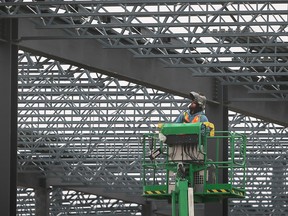
Article content
A forest of steel girders began rising behind Stellantis’s Automotive Research and Development Centre (ARDC) in Windsor this week.
The 100,000-square-foot standalone building will house the North American Battery Technology Centre and builds on the existing partnership with the University of Windsor at the ARDC.
Article content
“At Stellantis, we recognize the pivotal role that battery technology plays in electrifying the automotive industry,” said Ned Curic, Stellantis’s chief engineering and technology officer.
Advertisement 2
Story continues below
Article content
“Our forthcoming North America Battery Technology Centre in Windsor will be key to design, test and produce class-leading products that will meet our customers’ needs.”
Construction of the battery centre is part of the $3.6-billion commitment Stellantis announced in May 2022, with support from all three levels of government, to secure the future of its Windsor and Brampton assembly plants and expand its electric vehicle footprint.

The battery technology centre will be one of only two such facilities the world’s fourth-largest automaker will have and will be the hub for all North American battery research/testing for Stellantis. The other facility recently opened in Turin, Italy, to serve the company’s European market.
“The battery test lab included in the new Stellantis commitment to Windsor often gets overlooked in the shadow of the new (battery) plant,” said Automotive Parts Manufacturers’ Association president Flavio Volpe.
“However, it is a world-class hub for 650 engineers working on the most advanced technology in the world that would have been a headlining win for Canada if it was announced on its own.”
Advertisement 3
Story continues below
Article content
Construction of the facility is expected to be completed in mid-2024 and will become fully operational in the first quarter of 2025. More than $1 billion has been invested in research at the ARDC since its founding in 1996.
The Windsor facility will develop and test battery packs for future Stellantis products featuring battery electric, plug-in hybrid and hybrid batteries.
Related Stories
-

NextStar critics warned they’re putting future Canadian investments at risk
-

Observers say 2023 Unifor/UAW contract gains will make auto jobs attractive again
The battery centre will feature 35 walk-in climatic test cells for up to 63 battery packs and another 11 reach-in cells capable of handling 132 packs. The facility will test batteries in temperature ranges from –40 Celsius to 80 C.
“With multiple walk-in climatic test cells, we will rigorously evaluate batteries for pack testing, environmental durability tests, life cycle tests and systems validation,” Curic said.
“This comprehensive testing process ensures our EV batteries are built to withstand the test of time, performing optimally in various conditions and accelerates bringing cutting-edge electric vehicles to meet the needs of our customers.”
Advertisement 4
Story continues below
Article content
The facility will allow the company to integrate the capability to develop, test and manufacture battery packs and manage software in-house with a focus on improving performance and lowering costs.
Stellantis has added more than 650 engineers to the ARDC in the past year, pushing employment levels to 800 people. It’s the second-largest research/testing facility by employment levels the company has in North America after the Auburn Hills Technical Centre, which is part of Stellantis’s 5.4-million-square-foot corporate headquarters for this continent.
Twitter.com/winstarwaddell
Article content



Comments